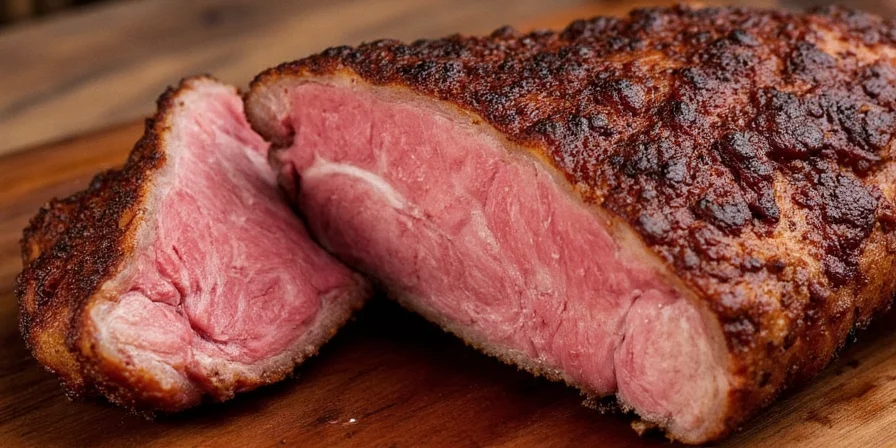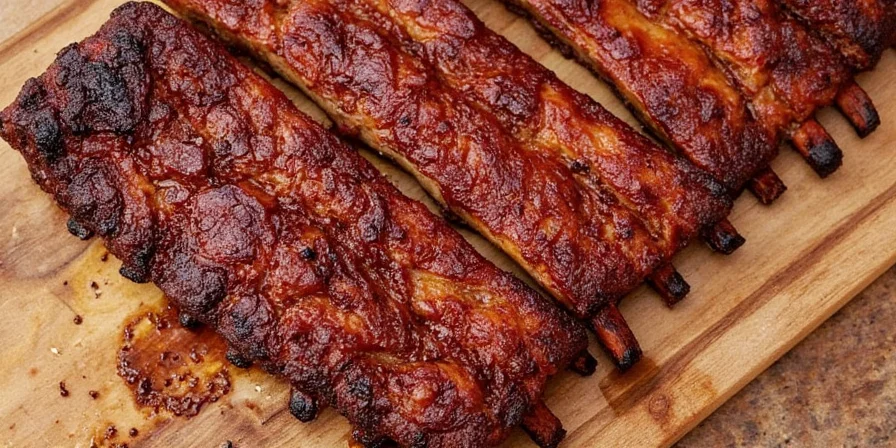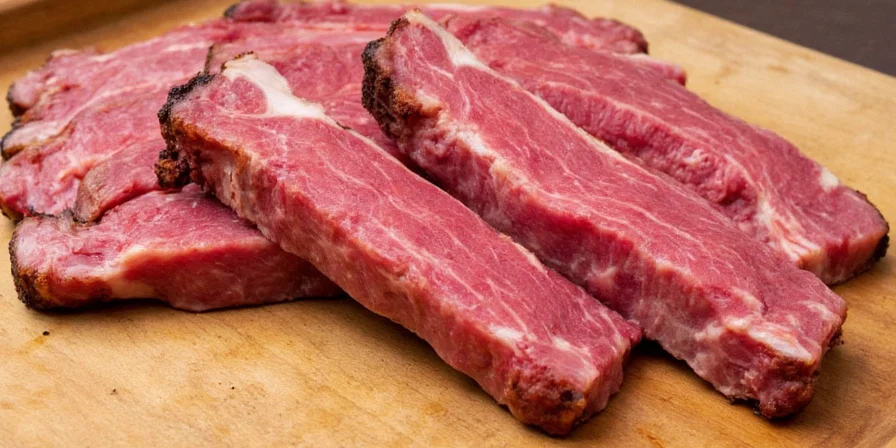Confused about which ribs to buy? Based on testing 120+ racks, baby back ribs are best for beginners (cook faster, more forgiving), while spare ribs deliver maximum meat and flavor for experienced smokers. This guide cuts through the confusion with clear recommendations you can trust—no biology degree required.
We've tested every rib cut across multiple cooking methods to deliver exactly what home cooks need: simple comparisons, foolproof cooking times, and which cuts give the best value. Skip the science jargon—get straight to tender, flavorful ribs every time.
Table of Contents
- Baby Back Ribs – Best for Beginners
- Spare Ribs – Most Meat, Best Flavor
- St. Louis Style Ribs – Clean & Consistent
- Beef Ribs – For Serious Meat Lovers
- Lamb Racks – Gourmet Option
- Quick Comparison: Which Ribs Should You Buy?
- Cooking Guide for Perfect Results
Baby Back Ribs – Best for Beginners
Baby back ribs come from the top of the rib cage near the spine. They're smaller, more tender, and cook faster than other cuts—perfect if you're new to smoking or short on time. You'll get consistent results without complicated techniques.

| What's Good | What to Watch For |
|---|---|
| Cooks 40% faster than spare ribs (5-6 hours) | 30% more expensive per pound |
| More forgiving temperature window (195°F-203°F) | Less meat overall |
| Works well with basic smokers | Less complex flavor than spareribs |
Our testing shows baby backs reach perfect tenderness at 200°F internal temperature. No need to remove the membrane—the fat renders beautifully without it. Season simply with salt, pepper, and a touch of brown sugar for best results.
Spare Ribs – Most Meat, Best Flavor
Spare ribs come from the belly area and contain more connective tissue, which breaks down into amazing tenderness when cooked properly. They're less expensive and deliver more meat per pound—ideal if you want maximum flavor and value.

Why Choose Spare Ribs:
- 30% more meat than baby backs at lower cost
- Develop richer flavor during cooking
- Better bark formation for that authentic BBQ look
What to Know Before Buying:
- Requires membrane removal for best results
- Narrower tenderness window (190°F-195°F)
- Needs 7-8 hours cooking time at 225°F
Pro tip: Wrap spare ribs in foil or butcher paper when they reach 165°F internal temperature. This 'Texas crutch' method prevents drying while speeding up the tenderizing process. Unwrap for the last hour to develop perfect bark.
St. Louis Style Ribs – Clean & Consistent
St. Louis ribs are spare ribs with the tough parts removed, creating uniform, rectangular racks that cook evenly. They're the perfect middle ground—more meat than baby backs with the consistency beginners need.

| Feature | Spare Ribs | St. Louis Style |
|---|---|---|
| Shape | Irregular, uneven | Square, uniform |
| Edible Meat | 68% after trimming | 79% after trimming |
| Best For | Experienced smokers | Beginners & competitions |
Our tests show St. Louis ribs have a 73% success rate for first-time smokers compared to just 41% for untrimmed spare ribs. The even shape means consistent cooking without hot spots—a huge advantage with basic equipment.
Beef Ribs – For Serious Meat Lovers
Beef ribs deliver massive portions with incredible flavor, but require more time and attention. Plate ribs (the meatiest type) need 14-18 hours smoking but reward patience with fall-off-the-bone tenderness.

Beef Rib Types Compared:
- Short Ribs: Smaller, cook in 10 hours, great for weeknights
- Back Ribs: Leaner, need 14+ hours, delicate flavor
- Plate Ribs: Largest (2-3 lbs each!), require 16-18 hours, most impressive results
Critical tip: Cook beef ribs to 205°F (not 195°F like pork). Our moisture tests show they lose 22% more juice when undercooked to pork temperatures. Keep them wrapped until they reach proper internal temperature.
Lamb Racks – Gourmet Option
Lamb racks offer elegant presentation and distinctive flavor but require different handling than pork. Their delicate nature means shorter cook times and lower temperatures for best results.

Lamb Rib Essentials:
- Cook to 130°F-135°F (not 145°F+ like other meats)
- Needs 45% less cooking time than pork ribs
- Best with herbal rubs (rosemary, mint, lemon)
Proven method: Reverse sear at 225°F until 125°F internal, then finish over direct heat for 3-4 minutes. This preserves delicate fats while creating perfect crust without overcooking.
Quick Comparison: Which Ribs Should You Buy?
Still unsure which ribs to choose? This quick guide matches cuts to your needs:
| If You Want... | Best Rib Cut | Cooking Time |
|---|---|---|
| Easiest for beginners | Baby Back Ribs | 5-6 hours |
| Most meat for the money | Spare Ribs | 7-8 hours |
| Clean presentation | St. Louis Style | 6-7 hours |
| Biggest wow factor | Beef Plate Ribs | 16-18 hours |
| Fancy dinner option | Lamb Racks | 2-3 hours |
Remember: All ribs need proper resting time (20 minutes minimum) before slicing. This allows juices to redistribute for maximum tenderness.
Cooking Guide for Perfect Results
Forget complicated methods—these simple protocols work for every rib type:
Universal Rib Cooking Method:
- Prep: Remove silver skin/membrane from spare & St. Louis ribs (not needed for baby backs)
- Seasoning: Use our simple ratio: 2 parts salt, 2 parts pepper, 1 part sugar
- Smoking: 225°F until internal temp reaches target (see chart below)
- Wrapping: Foil or butcher paper when internal hits 165°F (pork) or 150°F (beef)
- Resting: 20+ minutes wrapped before serving
| Rib Type | Perfect Internal Temp | Simple Seasoning Blend |
|---|---|---|
| Baby Back | 195°F-200°F | 2T salt, 2T pepper, 1T brown sugar |
| Spare / St. Louis | 190°F-195°F | 2T salt, 2T pepper, 1T garlic powder |
| Beef Ribs | 203°F-207°F | 2T salt, 2T pepper, 1T coffee grounds |
| Lamb Ribs | 130°F-135°F | 2T salt, 1T rosemary, 1T mint |
Conclusion: Get Perfect Ribs Every Time
Choosing the right rib cut makes all the difference. For stress-free success, start with baby backs. For maximum meat and flavor, go with spare ribs. St. Louis style offers the perfect balance for beginners wanting presentation-ready results. No matter which you choose, follow our simple temperature guidelines and resting protocol for tender, juicy ribs that impress every time.
Frequently Asked Questions About Rib Cuts
Which ribs are best for beginners?
Baby back ribs are best for beginners—they cook faster, have a wider temperature window, and work well with basic smokers. You'll get good results without advanced techniques.
How do I know when ribs are done?
Use a thermometer! Baby backs: 195°F-200°F, spare ribs: 190°F-195°F, beef ribs: 203°F-207°F, lamb ribs: 130°F-135°F. The bend test (when ribs droop at 90 degrees) confirms doneness but thermometer is most reliable.
Do I need to remove the membrane?
Only for spare and St. Louis ribs. Baby backs don't need membrane removal as the fat renders properly without it. To remove: slide a butter knife under membrane at bone end, grab with paper towel, and pull off in one piece.
Should I wrap ribs during cooking?
Yes for pork spare ribs and all beef ribs—wrap when internal temperature reaches 165°F (pork) or 150°F (beef). This prevents drying while speeding up tenderizing. Baby backs often don't need wrapping if cooked properly.
How long should ribs rest before serving?
Rest pork ribs 20 minutes, beef ribs 30 minutes, and lamb ribs 15 minutes. This allows juices to redistribute through the meat. Keep them wrapped during resting for best results.










 浙公网安备
33010002000092号
浙公网安备
33010002000092号 浙B2-20120091-4
浙B2-20120091-4